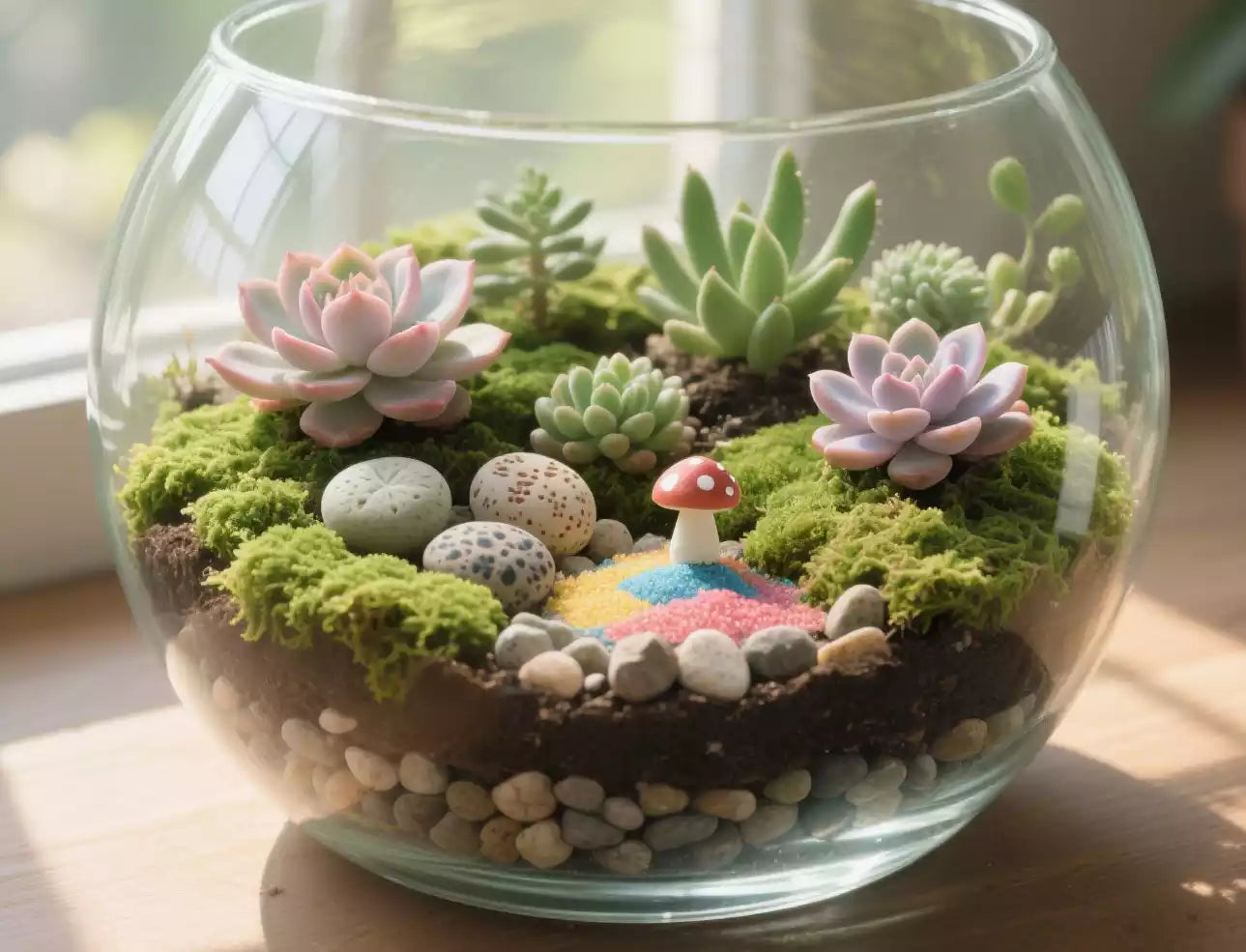
DIY Succulent Greenhouse Guide
From cozy family living rooms to creative studios, mini-landscapes in glass containers featuring succulents are becoming increasingly popular. These miniature, exquisite landscapes not only add a touch of nature to living spaces but also serve as unique decorative items that showcase personal style. If you'd like to create your succulent glass container mini-landscape, follow the steps below to get started!
Preparing Materials and Tools
Container Selection
Choosing the correct glass container is the first crucial step. Options such as wide-mouth jars, fish tanks, and glass jars are all suitable choices. For a more unique style, you can also browse second-hand markets or vintage stores for uniquely shaped old glassware. Note that the container should have sufficient depth and width to accommodate planting succulents and arranging the landscape, and ensure the glass is clean and free of damage.
Succulent Plant Selection
There are numerous succulent plant options available. It is recommended to select varieties with similar growth habits and plants of an appropriately sized. Common choices include the round and adorable peach egg succulent and the uniquely shaped lithops. You can purchase them at local flower markets or online platforms. When purchasing, prioritize healthy, robust plants that are free from pests and diseases.
Other Materials and Tools
In addition to containers and succulents, the following materials are required:
- Drainage layer materials: small stones, volcanic rock, or clay pellets to prevent waterlogging and root rot.
- Potting soil: Use specialized succulent potting soil, available at garden centers or supermarkets, or mix your own using peat moss, perlite, and vermiculite in the appropriate proportions.
- Decorative materials:Such as artificial animal figurines, mini mushrooms, colored sand, and small shells, can be used to add visual interest. You can also prepare moss to cover the soil surface for a more natural appearance.
- Tools: small shovel, tweezers, spray bottle, spoon, etc., for planting and arrangement.

Detailed steps for creation
Laying the drainage layer
First, lay a layer of small stones or clay pellets approximately 2–3 centimeters thick at the bottom of the glass container as the drainage layer. This step is crucial, as proper drainage effectively prevents waterlogging of the succulent plant roots, improving survival rates. Use a spoon to spread the material evenly, ensuring the surface remains as flat as possible.

Add planting soil
Cover the drainage layer with a layer of potting soil, with the thickness determined by the size of the container and the height of the succulent plant, typically 3–5 centimeters. Use a spoon to level the soil, preparing it for planting.
Planting the Succulent Plants
Use a small trowel to dig a small hole in the soil. Carefully remove the succulent plant from its original pot (keeping the root system intact as much as possible), place it in the hole, use tweezers to adjust its position gently, then use the trowel to fill in the surrounding soil, gently compacting it to secure the plant. Follow this method to plant the selected succulents in the container, ensuring adequate spacing to prevent the plants from crowding each other as they grow.

Decoration and Finishing Touches
After planting the succulents, it's time to get creative with decoration. Use tweezers to spread moss over the soil surface to create a grassy effect. Place artificial animal figurines in appropriate positions to create an interesting scene—sprinkle-colored sand to simulate paths or rivers. You can also add other decorative elements, according to your personal preference, to make the entire miniature landscape more unique.

Cleaning and Tidying
After completing the decoration, lightly spray a small amount of water with a spray bottle to slightly moisten the soil, helping the succulents adapt to their new environment. Simultaneously, use a clean, damp cloth to wipe the inner walls of the glass container, removing fingerprints and stains to keep the micro-landscape neat.
Daily Maintenance Tips
Light Management
Succulent glass container mini-landscapes require adequate but indirect sunlight. Place them near a brightly lit window indoors, such as a south- or east-facing window, ensuring 4–6 hours of sunlight daily. If the light is too strong, use curtains to provide shade and protect the succulents from scorching.
Watering Techniques
Succulents are drought-tolerant and do not require frequent watering. Generally, every 1–2 weeks, check the soil's dryness. When the soil surface turns white and dry, lightly spray the soil with a spray bottle to keep it slightly moist. Avoid overwatering, as this can lead to root rot. Additionally, avoid directly watering the succulent leaves to prevent water accumulation and rot.
Ventilation and Temperature
Maintaining good ventilation is essential for the growth of succulents. Regularly open windows to ventilate and circulate air. Succulents thrive in temperatures between 15 °C and 28°C. During summer, ensure proper heat protection and cooling. In winter, avoid exposure to low temperatures that could cause frostbite. When temperatures drop, move the micro-landscape to a warm indoor environment.

Creating a succulent glass container micro-landscape not only allows you to enjoy the fun of hands-on creation but also provides a unique little green space. Follow these steps to create your creative landscape and add more beauty to your life!
Share